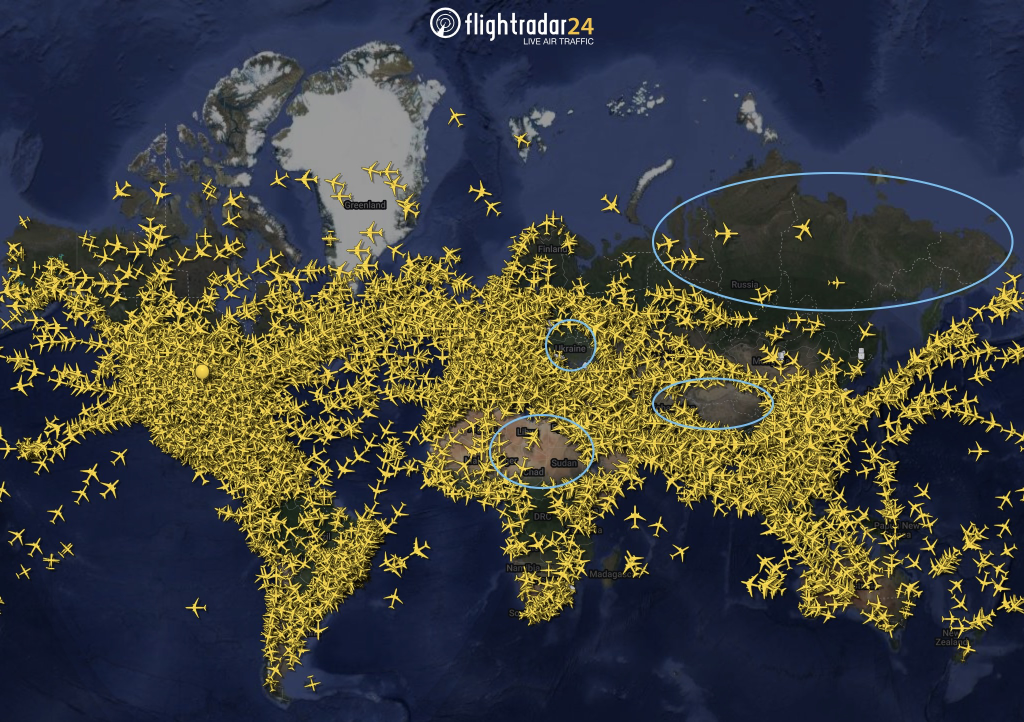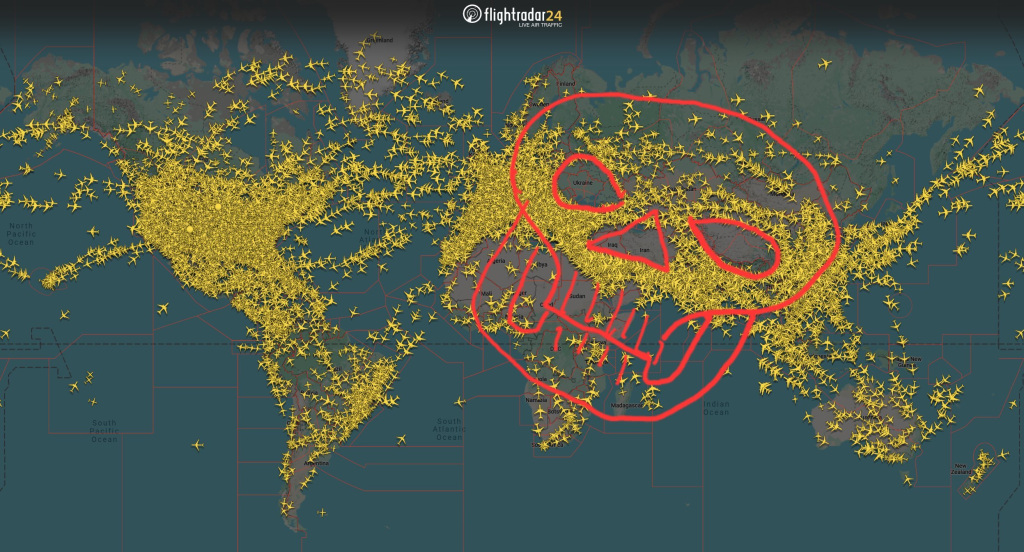FlightRadar24, a popular flight tracking website, posted a flight map on June 17, 2025, that revealed a disturbing skull-like pattern. Four gaps in worldwide flight patterns had coincidentally formed the shape of a human skull. The missing flight routes over Ukraine, Iran, Tibet, and Central Africa created what users described as death staring back from the world map. When the image went viral, FlightRadar24 used it to explain why airlines avoid these regions. The skull pattern has emerged from war zones and geographic barriers that stop air travel for safety purposes.
The Flight Map That Accidentally Showed Death’s Face
Eastern Europe and East Asia form the eye sockets, the Middle East creates the nose bridge, and Central Africa forms the mouth. These dead zones cover millions of square miles where airlines cannot fly. Ukraine’s absence comes from war, but Tibet’s emptiness comes from geography. Tibet sits at an average height of 14,800 feet with severe air turbulence, unpredictable weather, and few emergency landing spots. When cabin pressure fails, pilots must drop to 10,000 feet quickly, but a lot of Tibet sits above that height. Airlines cannot drop low enough in an emergency without hitting mountains.

Russia’s War Creates Flight Dead Zone
The left eye socket tells the most immediate story of human suffering. Russia’s 2022 invasion turned Ukraine into a no-fly zone, an area where planes cannot safely travel, but trouble started earlier. The 2014 Malaysian Airlines Flight MH17 tragedy in eastern Ukraine had already pushed airlines away from the region, creating the first visible gap on aviation maps.
Now the entire country remains off-limits to commercial traffic. War turned this region into one of the skull’s empty eye sockets. Busy air routes over Kyiv and eastern Ukraine that once carried thousands of passengers daily now sit dark and silent on aviation maps. The gap defines more than missing flights but shows a country under siege, where passenger jets can’t safely fly because missiles fill the air.
Missiles Force Airlines Around the Middle East
Iran and Israel’s missile exchanges create chaos for aviation, turning the Middle East into the skull’s nose bridge when entire air routes vanish overnight. The recent conflicts have made Iran, Iraq, Israel, Jordan, and Lebanon shut down flight operations during active fighting. This disrupts a region that serves as a connector between continents.
This creates problems for cities like Dubai, Doha, and Istanbul. These cities invested billions to become global travel hubs connecting Europe and Asia. When airlines regularly avoid the region during conflicts, these cities must scramble to maintain their status as connection points. Meanwhile, passengers and cargo find alternate routes around the chaos.
The dead zone represents much more than canceled flights. Unlike other aviation challenges that come and go, the Middle East faces recurring conflicts. These conflicts repeatedly make passenger jets navigate around missiles filling the airspace, creating a persistent hole in global travel patterns.
Read More: Why You Should Avoid Seat 11A on Your Next Flight – Here’s What You Didn’t Know
Failed States Create Aviation Wasteland
The skull’s mouth shows something even more disturbing than focused trauma or regional volatility. Here lies the wholesale collapse of stability across an entire swath of the continent. Central Africa forms the skull’s largest space, where multiple failing states have created an aviation wasteland. While other gaps come from single conflicts or geographic challenges, this region shows a wider collapse across multiple nations. Libya’s civil war has raged since 2014, tearing apart what was once a stable North African state. Sudan exploded into conflict in 2023 when government groups clashed with rebel groups, adding another layer of chaos to an already unstable region.
For airlines, this creates an impossible situation that extends far beyond dodging missiles. Even if pilots could fly safely through the active combat zones, an emergency landing becomes a nightmare scenario. A plane full of passengers would have nowhere to land safely, with no guarantee of medical assistance or mechanical support. The uncertainty makes airlines write off entire countries. This creates the skull’s most prominent feature on any flight tracking map, where millions of square miles become completely off-limits to commercial aviation.
Social Media Reacts to Death’s Head in the Sky
The skull image triggered major interest across X, with users racing to identify what created such eerie empty spaces. FlightRadar24 confirmed the gaps in Iran, Ukraine, and Tibet, which led to more serious questions about why these regions are being avoided. Several users explained that Tibet poses unique challenges for aviation.
The conversation took lighter turns when one user pointed out a gap above Oklahoma, and FlightRadar24 replied that it had “healed itself.” Another user noted heavy air traffic around Hawaii, connecting busy flight activity to economic strength and questioning recession fears.
What started as viral curiousness evolved into something educational. The website began sharing resources about flight-restricted regions. Users found themselves learning about war zones, mountains, and the factors that shape our skies through what began as an aviation tracking map.
What This Skull Pattern Shows
Beyond the social media buzz and aviation technicalities lies something more in-depth about what this accidental skull tells us about our world. The pattern shows how our fractured world accidentally took the shape of mortality itself. Flight maps usually appear as technical diagrams, but this one makes us confront something darker. Every empty area represents a place where normal life becomes impossible.

The aviation industry has adapted to volcanic ash clouds and pandemic lockdowns, but this skull-shaped pattern persists as a feature of our current world. Multiple crises compound each other, creating an image that spans continents. Our world’s troubles have formed the most unsettling picture possible, making us see the true cost of global instability reflected in something as mundane as air travel routes.
Read More: How a Suicide Bomber Was Blown Out of a Plane Mid-Flight, And What Came Next

